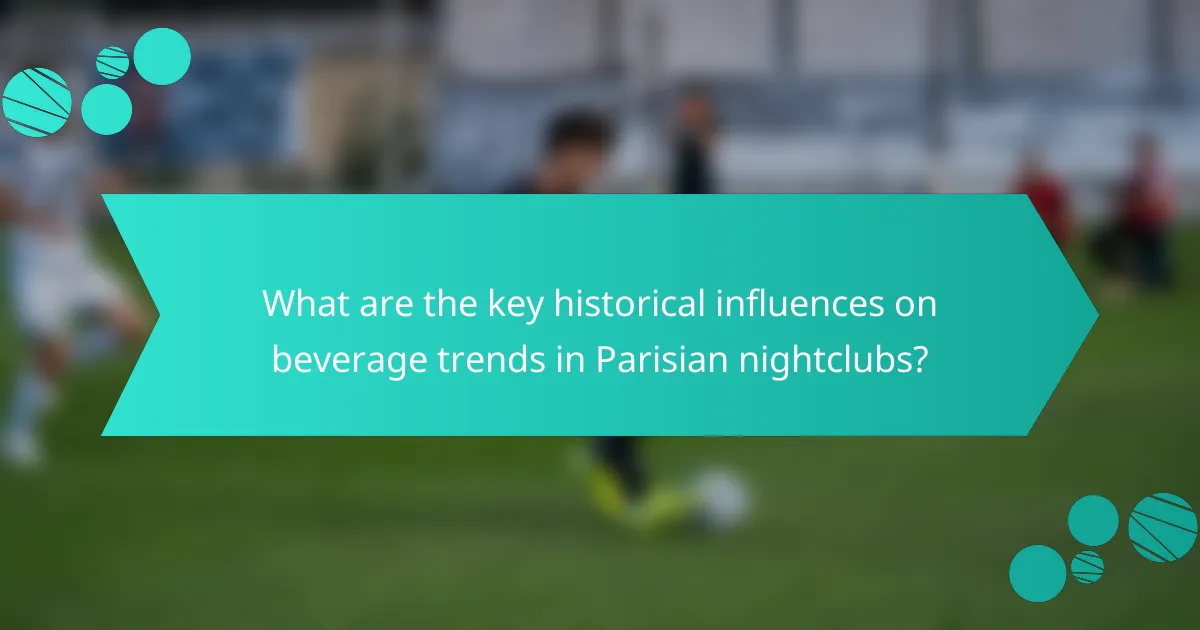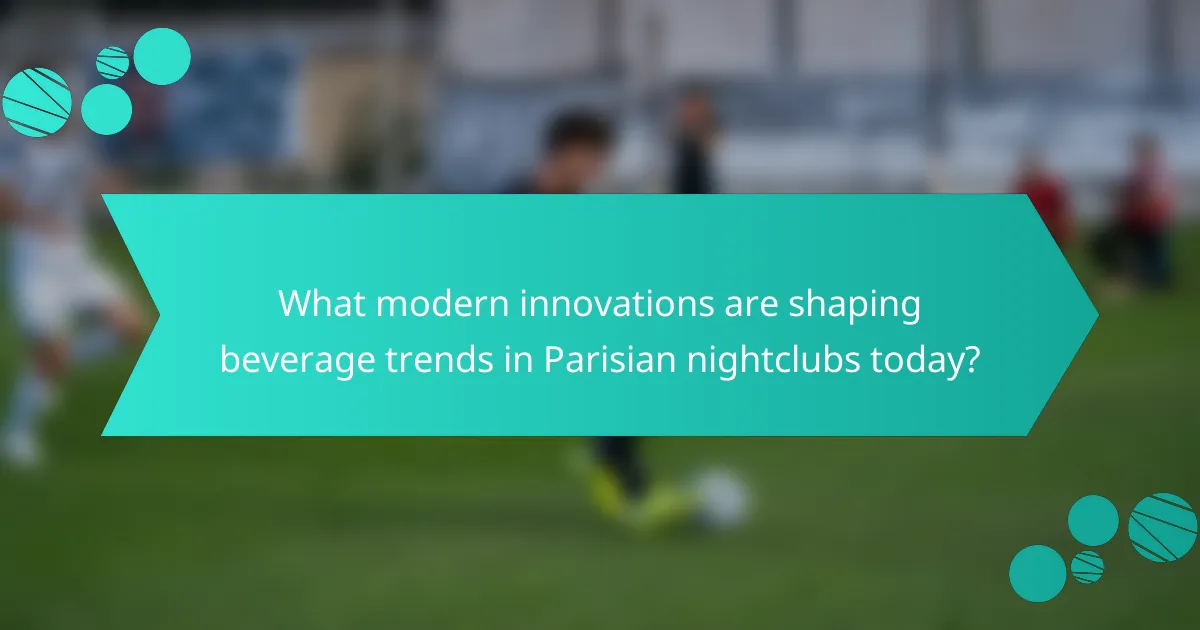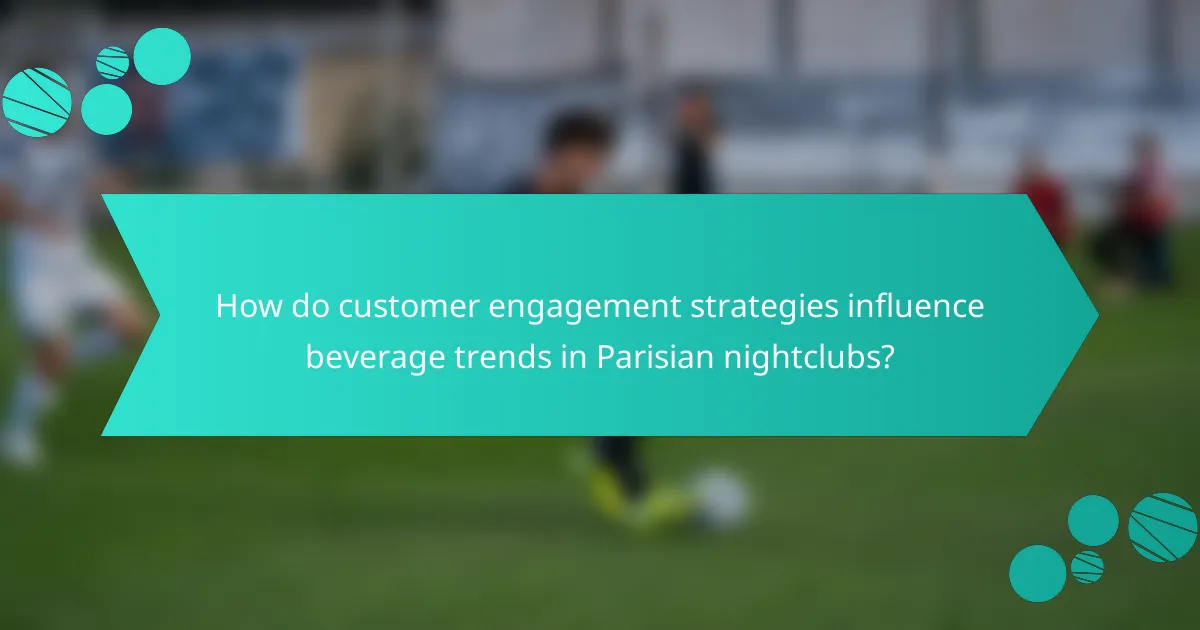The article examines the evolution of beverage trends in Parisian nightclubs, highlighting key historical influences, modern innovations, and customer engagement strategies. It outlines how cultural movements of the 20th century, such as the Jazz Age and the disco era, shaped drink preferences, while the emergence of craft cocktails in the 2000s marked a shift towards artisanal beverages. Modern trends emphasize advanced mixology techniques, sustainable ingredients, and technology integration, enhancing customer experience and convenience. Additionally, the article explores how interactive promotions and social media campaigns foster customer engagement, leading to increased loyalty and sales in innovative beverages.

What are the key historical influences on beverage trends in Parisian nightclubs?
Key historical influences on beverage trends in Parisian nightclubs include the cultural movements of the 20th century. The Jazz Age in the 1920s popularized cocktails and champagne. Prohibition in the United States led to an influx of American expatriates, bringing new drink styles. The rise of the disco era in the 1970s emphasized vibrant cocktails and energy drinks. Additionally, the influence of global cuisines introduced diverse flavors and ingredients. The emergence of craft cocktails in the 2000s marked a shift towards artisanal and locally sourced beverages. Each of these movements shaped the evolving preferences of nightclub patrons in Paris.
How did the cultural movements in Paris shape these beverage trends?
Cultural movements in Paris significantly influenced beverage trends. The avant-garde movements of the early 20th century encouraged experimentation in flavors and presentation. Artists and intellectuals frequented cafés, promoting unique beverage pairings with art and literature. The rise of the cocktail culture in the 1920s reflected a desire for sophistication and innovation. Prohibition in the United States led to an influx of American bartenders in Paris, introducing new cocktail recipes. The post-war existentialist movement emphasized simplicity and quality, leading to a resurgence of classic drinks. Additionally, the feminist movement in the 1970s brought attention to wine and spirits made by women. These cultural shifts fostered a dynamic beverage scene that continues to evolve in Parisian nightclubs today.
What role did the 1920s Parisian nightlife play in beverage evolution?
The 1920s Parisian nightlife significantly influenced beverage evolution. This era, known as the Jazz Age, saw a rise in social drinking and cocktail culture. Venues like the Moulin Rouge popularized mixed drinks, leading to a creative exploration of flavors. Bartenders began to experiment with ingredients, resulting in iconic cocktails such as the Sidecar and the French 75. The Prohibition in the United States also drove American expatriates to Paris, further enhancing the cocktail scene. This cross-cultural exchange introduced new spirits and techniques to Parisian bars. Consequently, the nightlife of the 1920s established a foundation for modern cocktail culture and global beverage trends.
How did post-war periods affect beverage choices in nightclubs?
Post-war periods significantly influenced beverage choices in nightclubs. After World War II, there was a surge in consumerism and a desire for new experiences. This led to an increased interest in cocktails and mixed drinks, which became popular in nightlife settings. The introduction of international brands and spirits also diversified options available to patrons.
In the 1950s and 1960s, the rise of jazz and rock and roll further shaped beverage trends. Nightclubs began to cater to younger audiences seeking vibrant atmospheres. This shift encouraged the use of colorful, visually appealing drinks.
Moreover, the economic recovery allowed for greater spending on luxury items, including premium spirits. The cultural exchanges from post-war globalization introduced new flavors and trends. These factors collectively transformed the beverage landscape in nightclubs during this era.
What traditional beverages have been popular in Parisian nightclubs over the decades?
Traditional beverages popular in Parisian nightclubs over the decades include absinthe, champagne, and cocktails. Absinthe gained popularity in the late 19th century and was associated with the bohemian culture. Champagne has long been a symbol of celebration in Parisian nightlife. Classic cocktails like the Martini and the Sidecar emerged during the 1920s and 1930s, reflecting the influence of American culture. In the 1980s, vodka-based drinks became trendy, aligning with global beverage trends. These beverages illustrate the evolving preferences of nightclub patrons in Paris.
Which classic cocktails have remained favorites in the nightlife scene?
Classic cocktails that have remained favorites in the nightlife scene include the Martini, Old Fashioned, and Manhattan. The Martini is known for its simple ingredients of gin and vermouth. This cocktail has been a staple since the late 19th century. The Old Fashioned combines whiskey, sugar, and bitters. It dates back to the early 1800s and is celebrated for its rich flavor. The Manhattan features whiskey, sweet vermouth, and bitters. This cocktail has been popular since the 1870s. These classic cocktails endure due to their timeless appeal and historical significance in cocktail culture. Their continued presence in bars reinforces their status as favorites among patrons.
How have local wines and spirits influenced nightclub beverage offerings?
Local wines and spirits have significantly influenced nightclub beverage offerings by promoting regional flavors and unique drinking experiences. Nightclubs have increasingly incorporated local wines and spirits to cater to consumer preferences for authenticity and local sourcing. This trend reflects a broader movement towards supporting local producers and enhancing the cultural experience of patrons.
Many nightclubs now feature curated drink menus that highlight local vineyards and distilleries. For instance, Parisian nightclubs often showcase French wines and artisanal spirits, creating a sense of place and tradition. This approach not only attracts tourists seeking local experiences but also appeals to locals who appreciate the regional identity in their beverages.
The rise of craft cocktails in nightclubs frequently utilizes local ingredients, further integrating local wines and spirits into the beverage landscape. This shift has led to an increase in collaborations between nightclubs and local producers, fostering a community-oriented atmosphere.
Data from industry reports indicate that nightclubs offering local beverages report higher customer satisfaction and increased patronage. This trend underscores the importance of local wines and spirits in shaping contemporary nightclub beverage offerings.

What modern innovations are shaping beverage trends in Parisian nightclubs today?
Modern innovations shaping beverage trends in Parisian nightclubs include mixology techniques, sustainable ingredients, and technology integration. Advanced mixology involves creative cocktail presentations and unique flavor pairings. Nightclubs are increasingly using organic and locally sourced ingredients to appeal to health-conscious consumers. Technology plays a significant role, with mobile apps for ordering and payment enhancing customer convenience. Additionally, some venues are incorporating augmented reality experiences to engage patrons. These trends reflect a shift towards personalization and sustainability in nightlife. As a result, Parisian nightclubs are becoming more dynamic and responsive to consumer preferences.
How are mixology techniques evolving in the current Parisian nightlife?
Mixology techniques in current Parisian nightlife are evolving through the integration of local ingredients and innovative presentation methods. Bartenders are increasingly focusing on artisanal spirits and seasonal produce. This shift reflects a growing emphasis on sustainability and craftsmanship in cocktail creation. Techniques such as barrel-aging and infusion are becoming more common. Additionally, the use of molecular gastronomy is gaining popularity, introducing unique textures and flavors.
Cocktail menus are also becoming more experimental, featuring unexpected flavor combinations. The rise of craft cocktails has led to an increased demand for skilled mixologists. Events and workshops are being organized to educate patrons about these evolving techniques. This evolution is supported by a vibrant community of bars and cocktail enthusiasts in Paris.
What are the latest trends in craft cocktails within these venues?
The latest trends in craft cocktails within Parisian nightclubs include the use of local ingredients, innovative flavor combinations, and sustainability practices. Venues are increasingly sourcing herbs, fruits, and spirits from nearby producers. This supports local agriculture and enhances cocktail freshness. Unique flavor pairings, such as savory elements with traditional sweet profiles, are gaining popularity. Additionally, the use of house-made mixers and infusions adds a personal touch to the drinks. Sustainability is also a key focus, with many bars reducing waste and using eco-friendly packaging. These trends reflect a growing consumer demand for quality and responsible sourcing in the nightlife experience.
How is technology impacting beverage preparation and service?
Technology is significantly impacting beverage preparation and service by enhancing efficiency and precision. Automated systems streamline the mixing and serving processes. Smart appliances allow for consistent beverage quality and faster service times. Mobile apps enable customers to place orders directly from their devices. This reduces wait times and improves the overall customer experience. Data analytics help bar managers understand customer preferences and optimize inventory. For example, point-of-sale systems track sales trends, allowing for better stock management. Overall, technology is transforming how beverages are prepared and served in modern establishments.
What role do sustainability and health trends play in modern beverage choices?
Sustainability and health trends significantly influence modern beverage choices. Consumers increasingly prefer beverages that are environmentally friendly and promote well-being. This shift reflects growing awareness of climate change and health issues. According to a 2021 Nielsen report, 73% of global consumers are willing to change their consumption habits to reduce environmental impact. Additionally, beverages with natural ingredients and low sugar content are gaining popularity. Brands that prioritize sustainability in sourcing and packaging attract more customers. This trend is evident in the rise of organic and plant-based beverages. Overall, sustainability and health trends shape consumer preferences and drive innovation in the beverage industry.
How are nightclubs adapting to the demand for organic and locally sourced ingredients?
Nightclubs are adapting to the demand for organic and locally sourced ingredients by revamping their beverage menus. They are sourcing fruits, herbs, and spirits from local farms and producers. This shift enhances flavor quality and supports local economies. Many establishments are also promoting seasonal cocktails that highlight these ingredients. Additionally, nightclubs are marketing their commitment to sustainability. They often display information about their sourcing practices on menus and social media. This transparency appeals to health-conscious consumers. A growing number of patrons prefer organic options, reflecting a broader trend in food and beverage preferences.
What are the emerging trends in low-alcohol and non-alcoholic beverages?
Emerging trends in low-alcohol and non-alcoholic beverages include a rise in creative formulations and flavor profiles. Brands are focusing on botanical ingredients to enhance taste. There is an increasing demand for health-conscious options. Consumers are seeking beverages with lower sugar content and natural ingredients. Craft non-alcoholic spirits are gaining popularity among younger demographics. Ready-to-drink low-alcohol cocktails are becoming more mainstream. The market for functional beverages, which offer health benefits, is expanding. According to a report by IWSR, the non-alcoholic beverage market is projected to grow significantly in the next few years.

How do customer engagement strategies influence beverage trends in Parisian nightclubs?
Customer engagement strategies significantly influence beverage trends in Parisian nightclubs. Nightclubs often utilize interactive promotions to attract patrons. These promotions may include mixology workshops or tastings. Engaging customers in this manner creates a sense of ownership over their beverage choices. Social media campaigns also play a crucial role in shaping trends. Clubs encourage patrons to share their experiences online. This generates buzz and influences others to try trending beverages. Additionally, personalized service enhances customer loyalty. When patrons feel valued, they are likely to return and recommend the venue. Research indicates that nightclubs that prioritize customer engagement see higher sales in innovative beverages. This demonstrates a direct correlation between engagement strategies and beverage trends.
What methods are nightclubs using to gather customer preferences?
Nightclubs gather customer preferences through surveys, social media engagement, and loyalty programs. Surveys allow nightclubs to collect direct feedback from patrons about their drink choices and overall experience. Social media platforms enable nightclubs to analyze trends and customer interactions, helping them tailor offerings. Loyalty programs incentivize repeat visits and provide insights into customer behavior and preferences. These methods collectively enhance customer engagement and inform beverage trends.
How do social media platforms impact beverage selection and marketing?
Social media platforms significantly influence beverage selection and marketing. They provide brands with a direct channel to engage consumers. Visual content on platforms like Instagram showcases beverages, driving trends. User-generated content, such as reviews and photos, shapes consumer perceptions. Brands leverage influencers to reach target audiences effectively. Data shows that 54% of social media users follow brands for product information. This engagement increases brand loyalty and awareness. Moreover, social media analytics help brands tailor their marketing strategies based on consumer preferences.
What role does customer feedback play in evolving beverage menus?
Customer feedback is essential in evolving beverage menus. It provides insights into customer preferences and trends. Nightclubs can adjust their offerings based on this feedback. For example, if patrons express a desire for more craft cocktails, venues can incorporate them. Additionally, feedback helps identify underperforming drinks. This allows for timely removal or replacement with more appealing options. Studies show that businesses that actively seek customer input see higher satisfaction rates. This, in turn, leads to increased customer loyalty and repeat visits. Overall, customer feedback directly influences the relevance and success of beverage menus.
How can nightclubs enhance the overall beverage experience for customers?
Nightclubs can enhance the overall beverage experience for customers by offering unique drink menus and personalized service. Innovative cocktails with high-quality ingredients attract customers. Seasonal and locally sourced ingredients can create freshness and variety. Interactive beverage experiences, such as cocktail-making classes, engage patrons and foster community. Implementing technology, like mobile ordering apps, streamlines service and reduces wait times. The ambiance of the nightclub, including lighting and music, complements the beverage experience. Training staff in mixology improves drink quality and customer interaction. These strategies collectively elevate customer satisfaction and loyalty.
What innovative events or promotions are being used to engage patrons?
Innovative events and promotions in Parisian nightclubs include themed parties, interactive drink tastings, and collaboration with local artists. Themed parties often revolve around specific cultures or eras, enhancing the immersive experience. Interactive drink tastings allow patrons to learn about mixology while enjoying unique cocktails. Collaborations with local artists provide live music or art displays, creating a vibrant atmosphere. These strategies effectively attract diverse audiences and foster community engagement. Nightclubs report increased patron attendance and satisfaction through these innovative approaches.
How can ambiance and presentation elevate beverage enjoyment in nightclubs?
Ambiance and presentation significantly enhance beverage enjoyment in nightclubs. A well-designed ambiance creates a sensory experience that influences mood and perception. Factors such as lighting, music, and decor contribute to an inviting atmosphere. Studies show that environments with lower lighting and upbeat music can increase patrons’ enjoyment. Presentation of beverages, including glassware and garnishes, also plays a crucial role. Visually appealing drinks can stimulate appetite and enhance the overall experience. Research indicates that aesthetically pleasing presentations lead to higher satisfaction ratings among customers. Together, ambiance and presentation create a holistic experience that elevates beverage enjoyment in nightclubs.
What best practices can nightclubs adopt to stay ahead in beverage trends?
Nightclubs can adopt several best practices to stay ahead in beverage trends. First, they should regularly analyze market trends and consumer preferences. Utilizing data analytics tools can provide insights into popular flavors and drink styles. Second, nightclubs should experiment with seasonal and local ingredients. This approach not only attracts customers but also supports local producers. Third, offering unique and signature cocktails can differentiate a nightclub from competitors. Creating a drink menu that reflects current trends, such as low-alcohol or non-alcoholic options, is essential. Fourth, engaging with customers through social media can help gather feedback on beverage offerings. This direct interaction fosters loyalty and keeps nightclubs informed on preferences. Lastly, staff training on mixology and beverage trends enhances customer experience. Knowledgeable bartenders can provide recommendations and create a more engaging environment.
The main entity of the article is the evolution of beverage trends in Parisian nightclubs. This article examines key historical influences, such as the Jazz Age, Prohibition, and post-war cultural movements, that have shaped beverage preferences over the decades. It also explores modern innovations in mixology, the impact of sustainability and health trends, and customer engagement strategies that influence contemporary beverage offerings. Additionally, the article highlights the role of local ingredients and technology in enhancing the nightlife experience, as well as best practices for nightclubs to stay ahead in beverage trends.